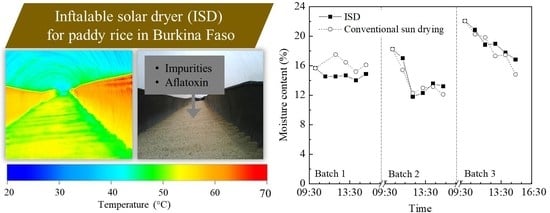Drying Performance and Aflatoxin Content of Paddy Rice Applying an Inflatable Solar Dryer in Burkina Faso
Abstract
:1. Introduction
2. Materials and Methods
2.1. Drying Experiment
2.2. Measurement of the Operating Conditions
2.3. Quality Determination
2.4. Statistical Analysis
3. Results and Discussion
3.1. Solar Radiation, Electricity Generation, Temperature and Relative Humidity
3.2. Drying Performance of Inflatable Solar Dryer Compared to Conventional Sun Drying
3.3. Impurities and Aflatoxins of Paddy Rice
4. Conclusions
Author Contributions
Funding
Acknowledgments
Conflicts of Interest
References
- Baoua, I.B.; Amadou, L.; Bakoye, O.; Baributsa, D.; Murdock, L.L. Triple bagging hermetic technology for post-harvest preservation of paddy rice Oryza sativa L. in the Sahel of West Africa. J. Stored Prod. Res. 2016, 68, 73–79. [Google Scholar] [CrossRef]
- Kuenzer, C.; Knauer, K. Remote sensing of rice crop areas. Int. J. Remote Sens. 2013, 34, 2101–2139. [Google Scholar] [CrossRef]
- Awika, J.M. Major cereal grains production and use around the world. In ACS Symposium Series; American Chemical Society: Washington, DC, USA, 2011; Volume 1089, pp. 1–13. [Google Scholar]
- IRRI Rice Knowledge Bank. Rice Knowledge Bank; IRRI (International Rice Research Institute): Los Baños, Philippines, 2018. [Google Scholar]
- Bhattacharya, K.R. Rice Quality: A Guide to Rice Properties and Analysis; Woodhead Publishing Limited: Cambridge, UK, 2011; Volume 219, pp. 1–608. [Google Scholar]
- Udomkun, P.; Wiredu, A.N.; Nagle, M.; Bandyopadhyay, R.; Müller, J.; Vanlauwe, B. Mycotoxins in Sub-Saharan Africa: Present situation, socio-economic impact, awareness, and outlook. Food Control 2017, 72, 110–122. [Google Scholar] [CrossRef]
- Lewis, L.; Onsongo, M.; Njapau, H.; Schurz-Rogers, H.; Luber, G.; Kieszak, S.; Nyamongo, J.; Backer, L.; Dahiye, A.M.; Misore, A.; et al. Aflatoxin contamination of commercial maize products during an outbreak of acute aflatoxicosis in eastern and central Kenya. Environ. Health Perspect. 2005, 113, 1763–1767. [Google Scholar] [CrossRef]
- Mutegi, C.; Wagacha, M.; Kimani, J.; Otieno, G.; Wanyama, R.; Hell, K.; Christie, M.E. Incidence of aflatoxin in peanuts (Arachis hypogaea Linnaeus) from markets in Western, Nyanza and Nairobi Provinces of Kenya and related market traits. J. Stored Prod. Res. 2013, 52, 118–127. [Google Scholar] [CrossRef] [Green Version]
- IARC. IARC Monographs on the Evaluation of the Carcinogenic Risks to Humans; IARC Press: Lyon, France, 2002; Volume 82, pp. 169–345. [Google Scholar]
- Hove, M.; Van Poucke, C.; Njumbe-Ediage, E.; Nyanga, L.K.; De Saeger, S. Review on the natural co-occurrence of AFB1 and FB1 in maize and the combined toxicity of AFB1 and FB1. Food Control 2016, 59, 675–682. [Google Scholar] [CrossRef]
- European Commission-EC. Commission regulation (EU) no 165/2010 of 26 February 2010, amending regulation (EC) no 1881/2006 setting maximum levels for certain contaminants in foodstuffs as regards aflatoxin. In Official Journal of the European Union; Union, E., Ed.; Publications Office of the European Union: Brussels, Belgium, 2010; Volume 50, pp. 8–12. [Google Scholar]
- Gowda, N.K.S.; Suganthi, R.U.; Malathi, V.; Raghavendra, A. Efficacy of heat treatment and sun drying of aflatoxin-contaminated feed for reducing the harmful biological effects in sheep. Anim. Feed Sci. Technol. 2007, 133, 167–175. [Google Scholar] [CrossRef]
- Chua, K.J.; Chou, S.K. Low-cost drying methods for developing countries. Trends Food Sci. Technol. 2003, 14, 519–528. [Google Scholar] [CrossRef]
- Janjai, S.; Bala, B.K. Solar Drying Technology. Food Eng. Rev. 2012, 4, 16–54. [Google Scholar] [CrossRef]
- Bala, B.K.; Janjai, S. Solar drying of agricultural products. Stewart Postharvest Rev. 2013, 9, 1–8. [Google Scholar]
- Müller, J.; Mühlbauer, W. Solar Drying. In Modern Drying Technology; Tsotsas, E., Mujumdar, A.S., Eds.; Wiley-VCH Verlag GmbH & Co. KGaA: Weinheim, Germany, 2012; Volume 4, pp. 199–243. [Google Scholar]
- Mekhilef, S.; Faramarzi, S.Z.; Saidur, R.; Salam, Z. The application of solar technologies for sustainable development of agricultural sector. Renew. Sustain. Energy Rev. 2013, 18, 583–594. [Google Scholar] [CrossRef]
- Sandali, M.; Boubekri, A.; Mennouche, D. Improvement of the Thermal Performance of Solar Drying Systems Using Different Techniques: A Review. J. Sol. Energy Eng. Trans. ASME 2019, 141, 050802. [Google Scholar] [CrossRef]
- Sharma, A.; Chen, C.R.; Vu Lan, N. Solar-energy drying systems: A review. Renew. Sustain. Energy Rev. 2009, 13, 1185–1210. [Google Scholar] [CrossRef]
- Ekechukwu, O.V.; Norton, B. Review of solar-energy drying systems II: An overview of solar drying technology. Energy Convers. Manag. 1999, 40, 615–655. [Google Scholar] [CrossRef]
- Fudholi, A.; Sopian, K.; Ruslan, M.H.; Alghoul, M.A.; Sulaiman, M.Y. Review of solar dryers for agricultural and marine products. Renew. Sustain. Energy Rev. 2010, 14, 1–30. [Google Scholar] [CrossRef]
- Salvatierra-Rojas, A.; Nagle, M.; Gummert, M.; de Bruin, T.; Müller, J. Development of an inflatable solar dryer for improved postharvest handling of paddy rice in humid climates. Int. J. Agric. Biol. Eng. 2017, 10, 269–282. [Google Scholar]
- Asemu, A.M.; Habtu, N.G.; Delele, M.A.; Subramanyam, B.; Alavi, S. Drying characteristics of maize grain in solar bubble dryer. J. Food Process Eng. 2020, 43, e13312. [Google Scholar] [CrossRef]
- Nguyen Van, H.; Tran Van, T.; Meas, P.; Tado, C.J.M.; Kyaw, M.A.; Gummert, M. Best practices for paddy drying: Case studies in Vietnam, Cambodia, Philippines, and Myanmar. Plant Prod. Sci. 2019, 22, 107–118. [Google Scholar] [CrossRef]
- DIN CEN/TS 14774-3. Determination of moisture content—Oven dry method. In Part 3: Moisture in General Analysis Sample; Deutsches Institut für Normung e.V: Berlin, Germany, 2004. [Google Scholar]
- ISO 658. Oilseeds—Determination of Content of Impurities; International Organization for Standardization: Geneva, Switzerland, 2002; pp. 1–10. [Google Scholar]
- AOAC. Official Methods of Analysis of AOAC International; AOAC International: Gaithersburg, MD, USA, 1998. [Google Scholar]
- Kamimura, H.; Nishijima, M.; Yasuda, K.; Ushiyama, H.; Tabata, S.; Matsumoto, S.; Nishima, T. Simple, rapid cleanup method for analysis of aflatoxins and comparison with various methods. J. Assoc. Off. Anal. Chem. 1985, 68, 458–461. [Google Scholar] [CrossRef]
- Wilson, T.J.; Romer, T.R. Use of the Mycosep multifunctional cleanup column for liquid chromatographic determination of aflatoxins in agricultural products. J. - Assoc. Off. Anal. Chem. 1991, 74, 951–956. [Google Scholar] [CrossRef]
- Shantha, T. Methods for estimation of aflatoxins: A critical appraisal. J. Food Sci. Technol. 1994, 31, 91–103. [Google Scholar]
- Nagle, M.; González-Azcárraga, J.C.; Phupaichitkun, S.; Mahayothee, B.; Haewsungcharern, M.; Janjai, S.; Leis, H.; Müller, J. Effects of operating practices on performance of a fixed-bed convection dryer and quality of dried longan. Int. J. Food Sci. Technol. 2008, 43, 1979–1987. [Google Scholar] [CrossRef]
- Tippayawong, N.; Tantakitti, C.; Thavornun, S.; Peerawanitkul, V. Energy conservation in drying of peeled longan by forced convection and hot air recirculation. Biosyst. Eng. 2009, 104, 199–204. [Google Scholar] [CrossRef]
- El-Sebaii, A.A.; Shalaby, S.M. Solar drying of agricultural products: A review. Renew. Sustain. Energy Rev. 2012, 16, 37–43. [Google Scholar] [CrossRef]
- Janjai, S.; Khamvongsa, V.; Bala, B.K. Development, design, and performance of a PV-Ventilated greenhouse dryer. Int. Energy J. 2007, 8, 249–258. [Google Scholar]
- Sarker, M.S.H.; Ibrahim, M.N.; Aziz, N.A.; Punan, M.S. Application of simulation in determining suitable operating parameters for industrial scale fluidized bed dryer during drying of high impurity moist paddy. J. Stored Prod. Res. 2015, 61, 76–84. [Google Scholar] [CrossRef]
- Rustom, I.Y.S. Aflatoxin in food and feed: Occurrence, legislation and inactivation by physical methods. Food Chem. 1997, 59, 57–67. [Google Scholar] [CrossRef]
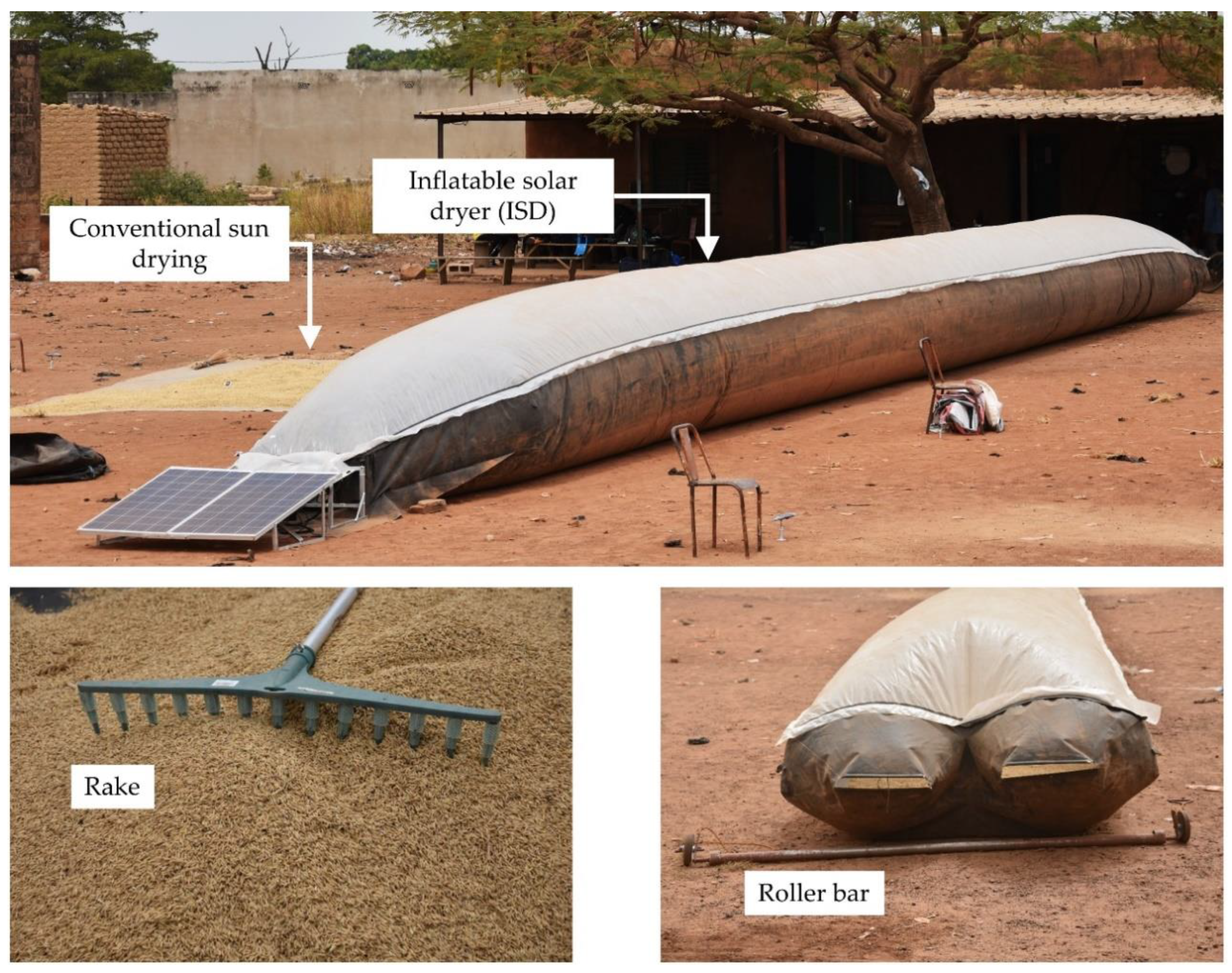
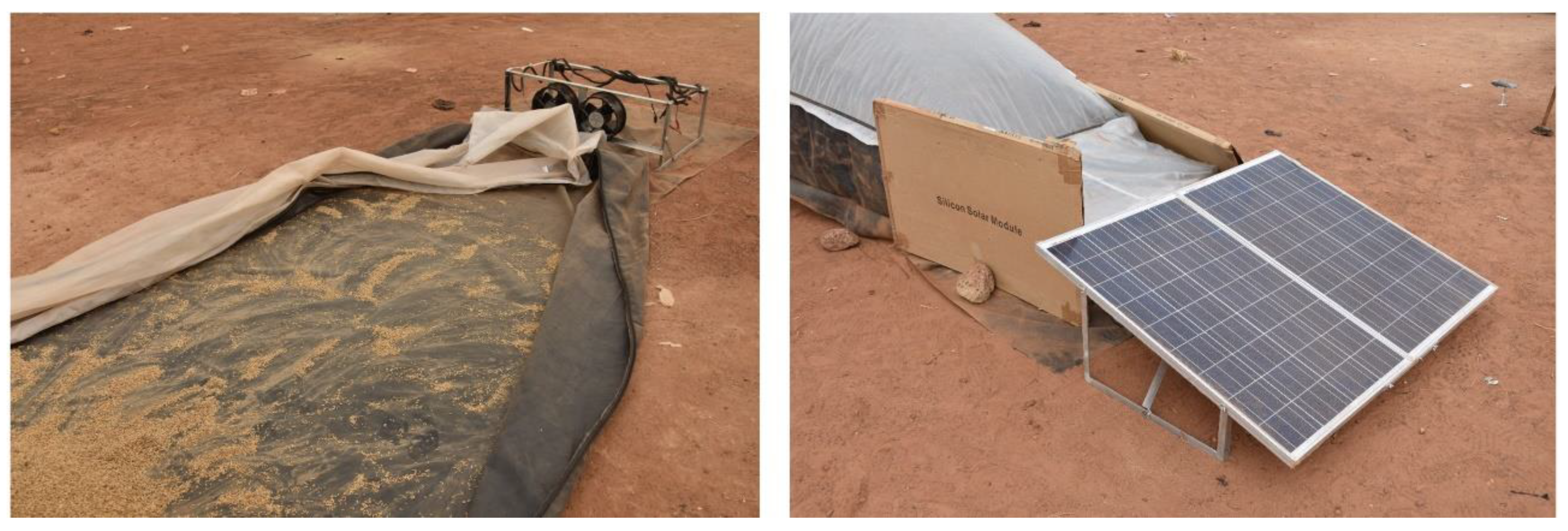
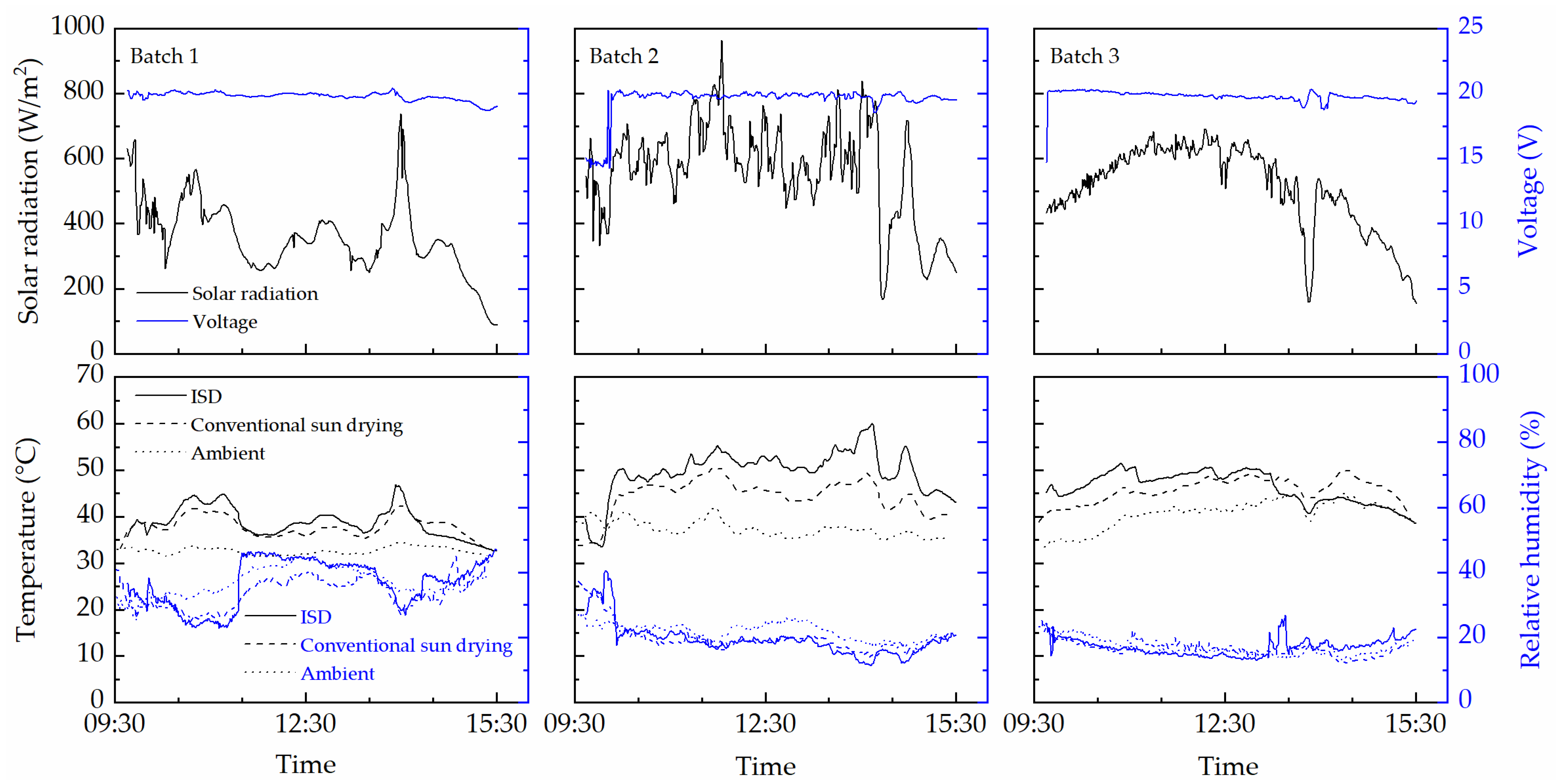
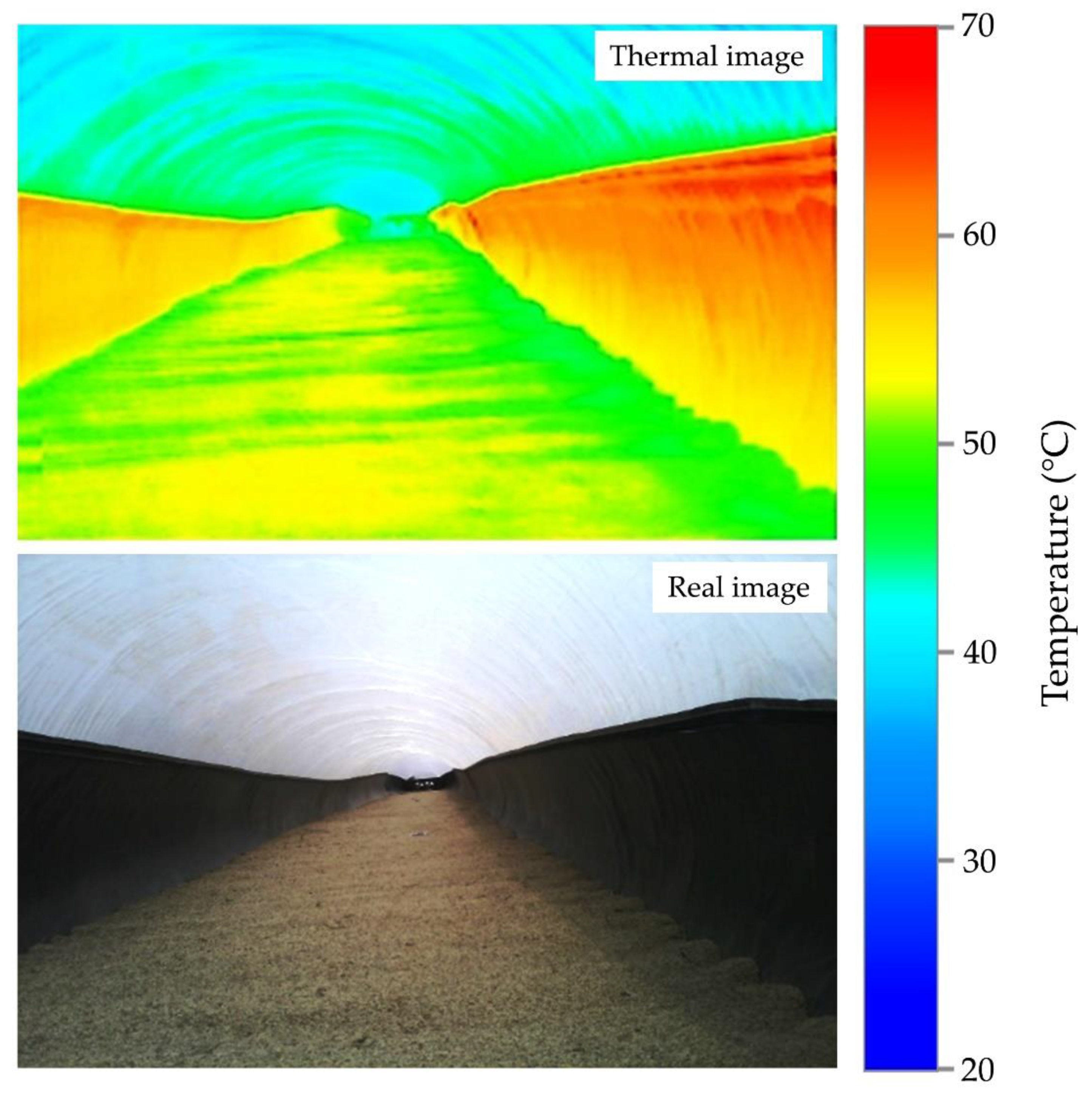

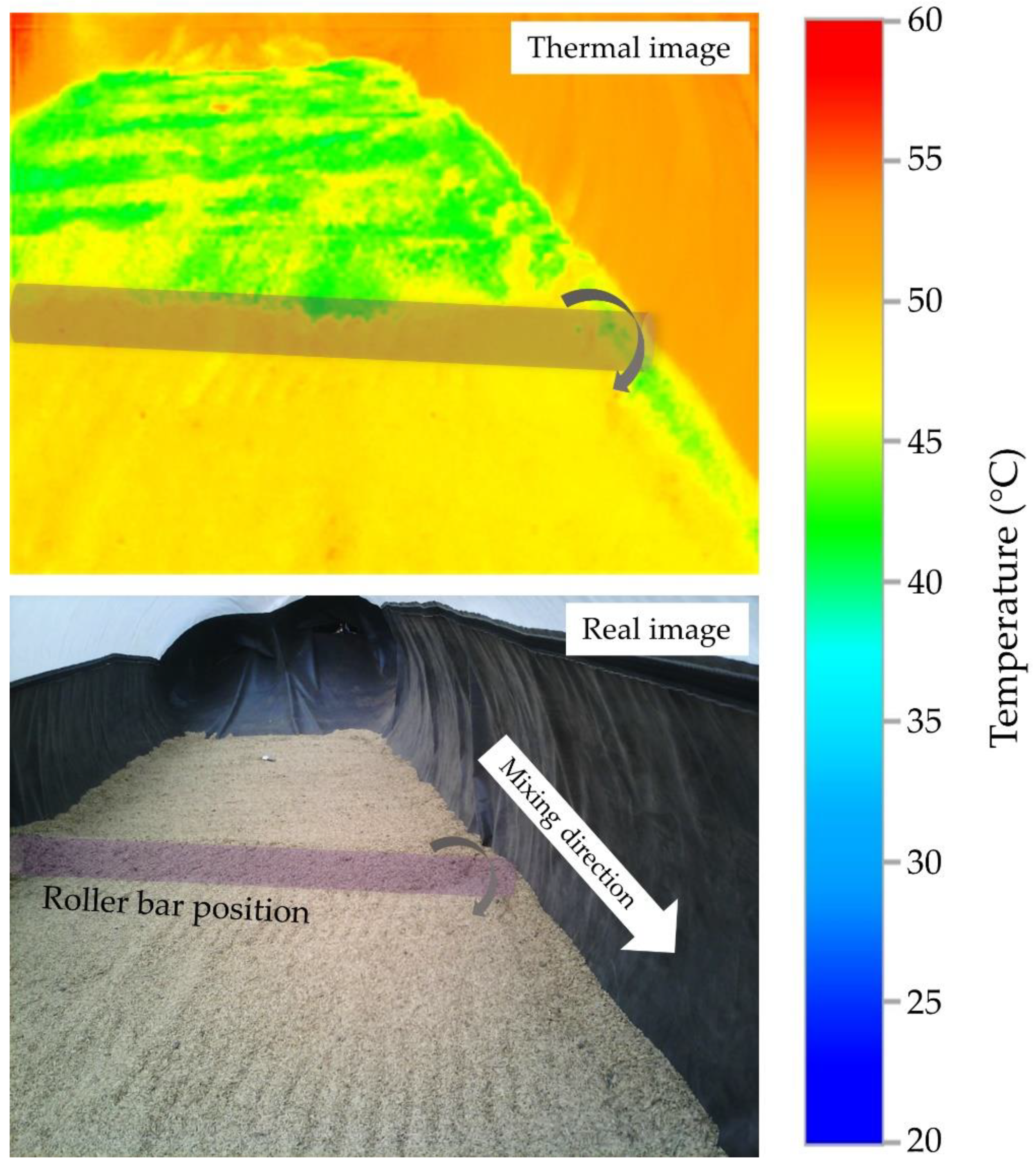
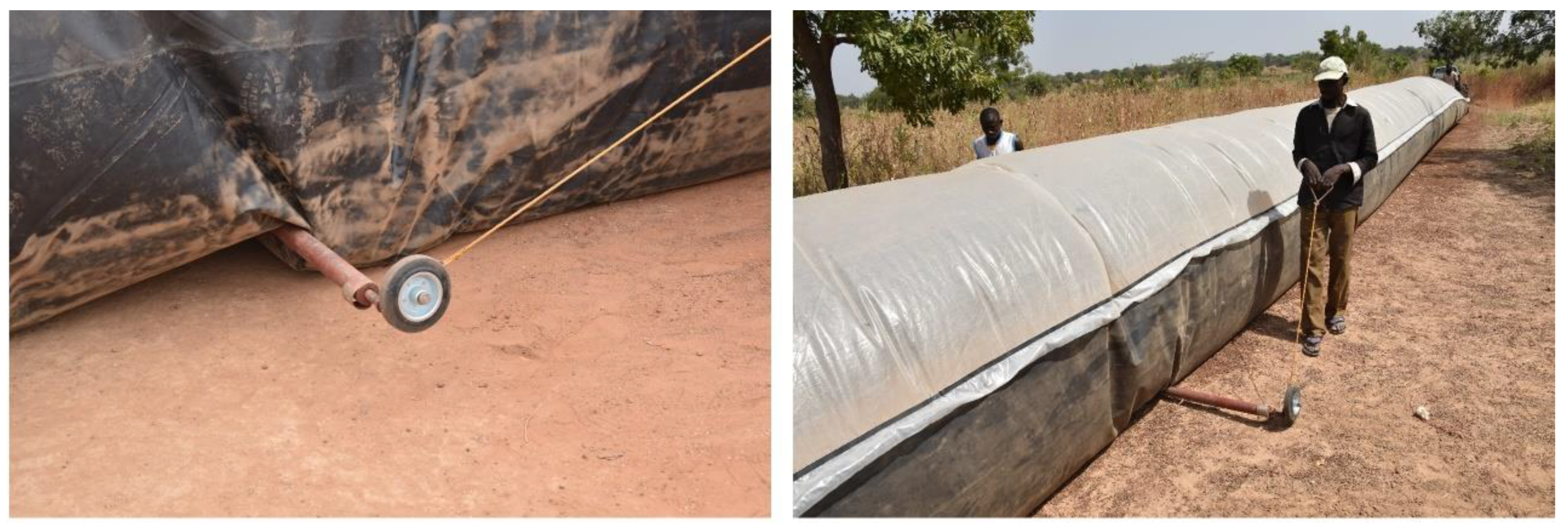
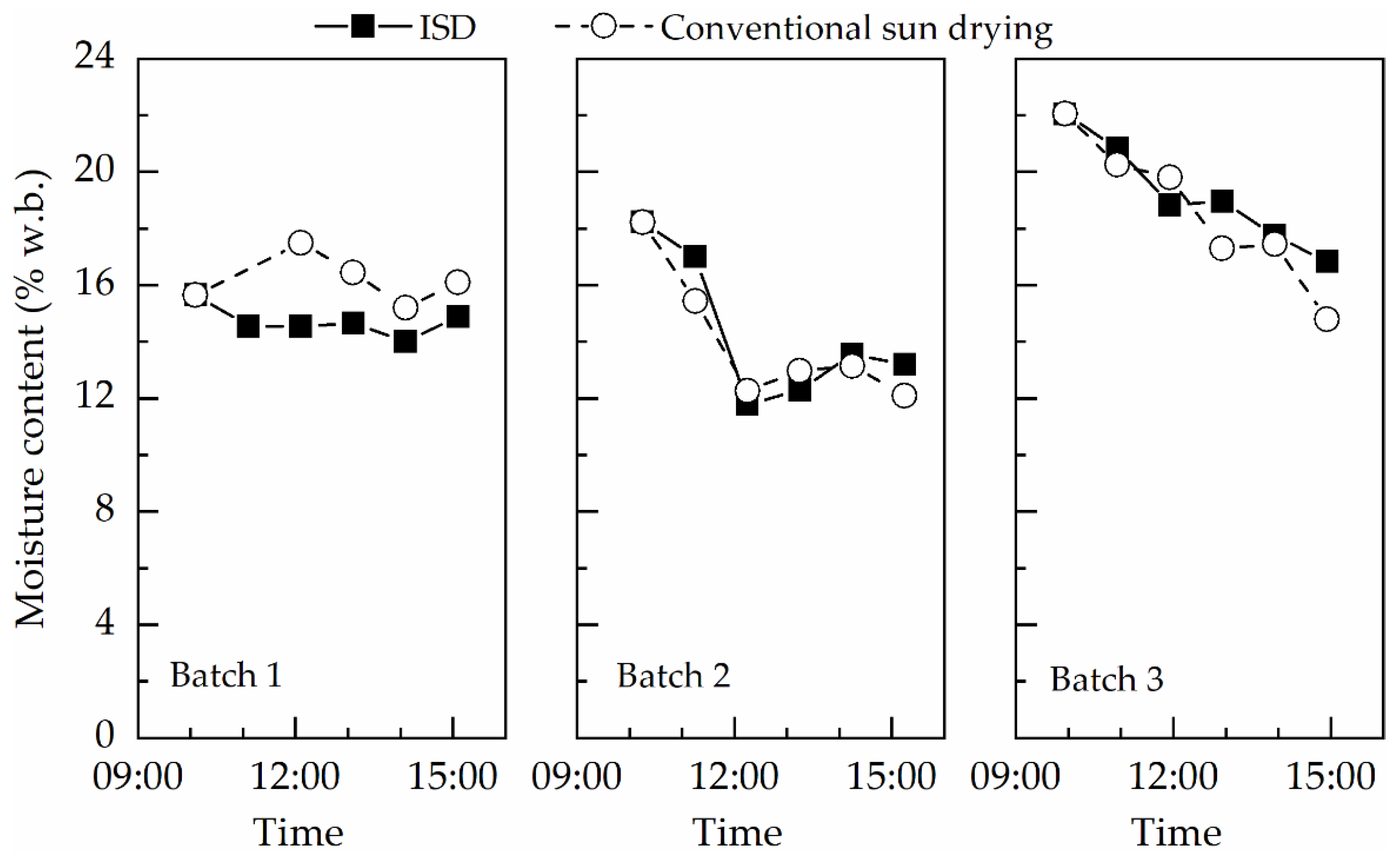
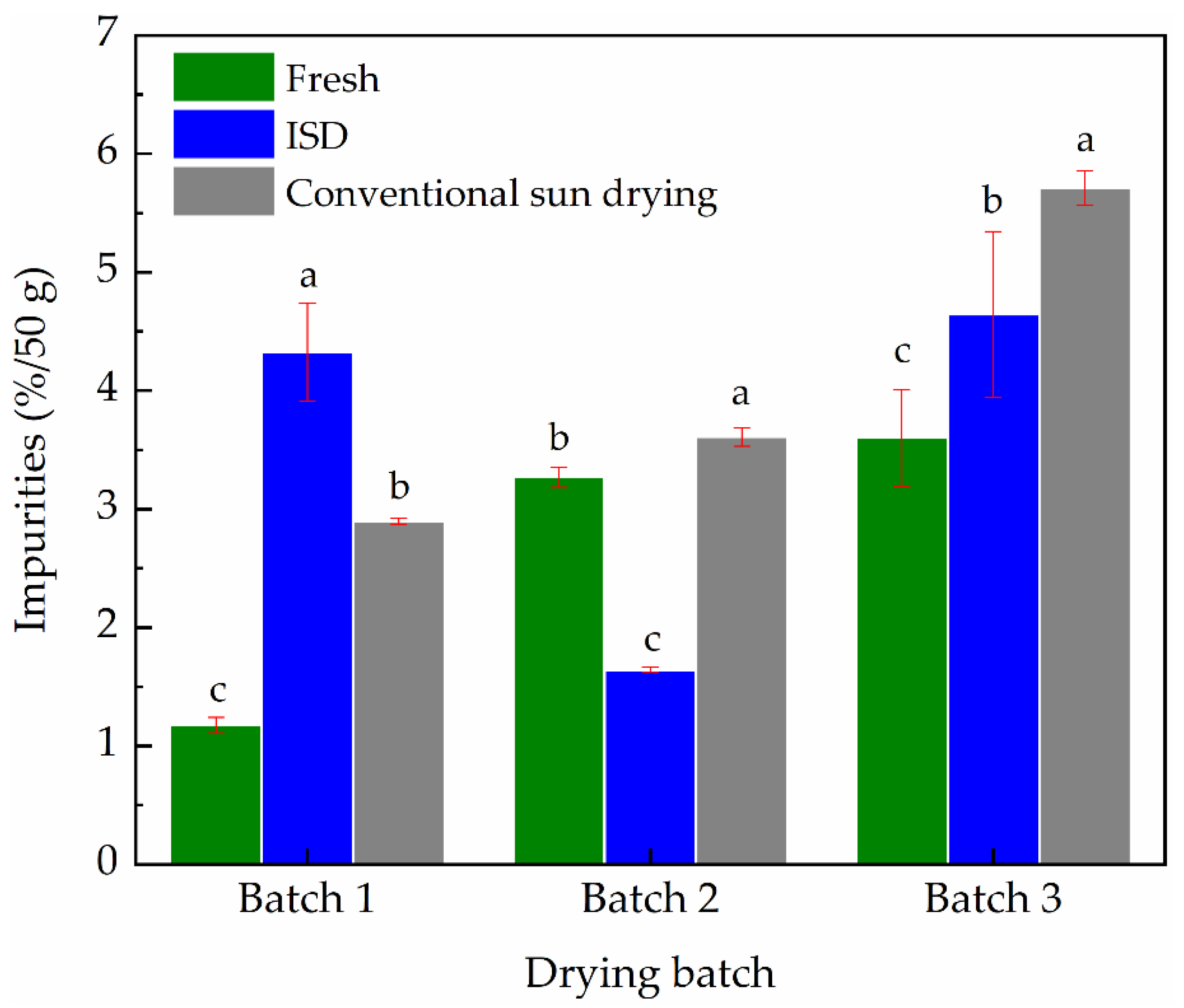
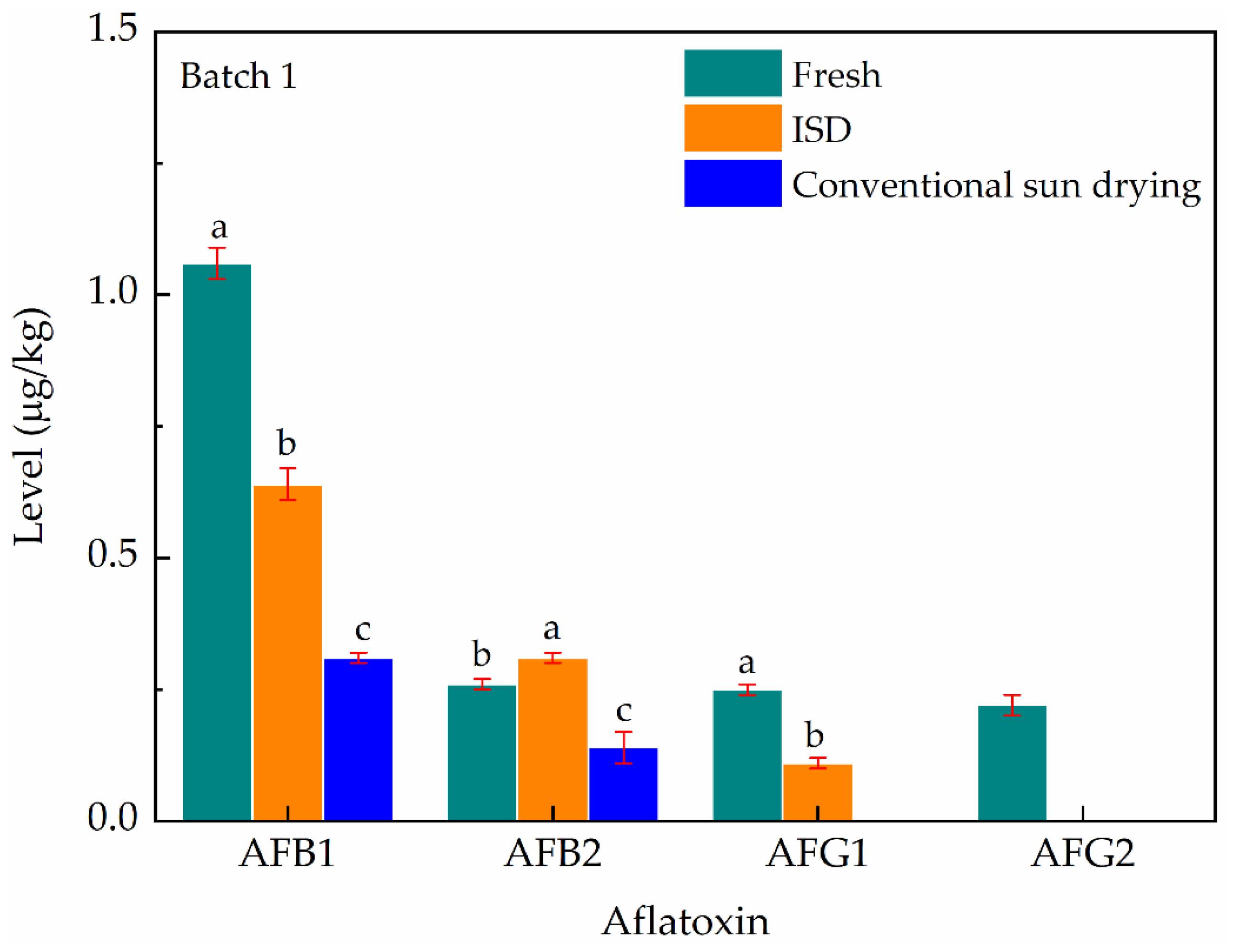
© 2020 by the authors. Licensee MDPI, Basel, Switzerland. This article is an open access article distributed under the terms and conditions of the Creative Commons Attribution (CC BY) license (http://creativecommons.org/licenses/by/4.0/).
Share and Cite
Romuli, S.; Schock, S.; Somda, M.K.; Müller, J. Drying Performance and Aflatoxin Content of Paddy Rice Applying an Inflatable Solar Dryer in Burkina Faso. Appl. Sci. 2020, 10, 3533. https://doi.org/10.3390/app10103533
Romuli S, Schock S, Somda MK, Müller J. Drying Performance and Aflatoxin Content of Paddy Rice Applying an Inflatable Solar Dryer in Burkina Faso. Applied Sciences. 2020; 10(10):3533. https://doi.org/10.3390/app10103533
Chicago/Turabian StyleRomuli, Sebastian, Steffen Schock, Marius Kounbèsiounè Somda, and Joachim Müller. 2020. "Drying Performance and Aflatoxin Content of Paddy Rice Applying an Inflatable Solar Dryer in Burkina Faso" Applied Sciences 10, no. 10: 3533. https://doi.org/10.3390/app10103533





